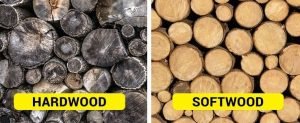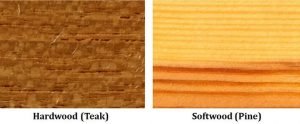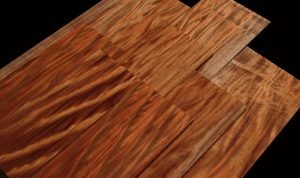Hardwood Vs Softwood – 15 Differences, Advantages & Disadvantages
Hardwood vs softwood is the comparison between them and comes down to its physical structure and makeup as being hard and durable compared to softwood, it is overly simplistic to think of hardwoods and softwood as also workable.

From angiosperm or flowering plants such as oak, maple, or walnut, that are not monocots, the hardwood is formed by while from gymnosperm trees, usually evergreen conifers, like pine or spruce, the softwood is formed.
Hardwood Vs Softwood Comparison:

Characteristics | Hardwood | Softwood |
Definition | From angiosperm trees that are not monocots and are usually broad-leaved and Have vessel elements that transport water throughout the wood, hardwood is formed and these elements appear as pores under a microscope. | From gymnosperm trees which usually have needles and cones and rays, softwood is formed and tracheids transport water and produce sap and have no visible pores because tracheids are under a microscope. |
Uses | In high-quality furniture, decks, flooring, and construction that need to last, hardwoods are more likely used. | In building components like windows, doors, furniture, medium-density fiberboard, & paper, softwoods are used. |
Density | Hardwoods have a higher density than most softwoods. | Softwoods have a lower density than most hardwoods. |
Cost | These woods are more expensive than softwoods. | These woods are less expensive as compared to hardwood. |
Growth | The rate of growth is slower for hardwoods | The rate of growth is faster than hardwood. |
Shedding of Leaves | Over a period of time in autumn and winter hardwoods shed their leaves. | Throughout the year softwoods tend to keep their needles. |
Trees Example | Alder, balsa, beech, hickory, mahogany, maple, oak, teak, and walnut are examples of hardwoods. | Cedar, Douglas fir, juniper, pine, redwood, spruce, and yew are examples of softwoods. |
Fire Resistance | Hardwoods have more fire resistance. | Softwoods have poor fire resistance. |
Weight | These woods are harder and heavier than softwoods. | These woods are lightweight and softer as compared to hardwoods. |
Colour | Hardwoods are dark-coloured woods. | Light in colour. |
Weather Resistance | These woods are having less environmental impact and are naturally resistant to weather. | Having an environmental impact, if treated then these may become resistant to weather. |
Ring Structure | There are no distinct annual rings. | There are distinct annual rings. |
Tensile & Shear Strength | These woods have good shear and tensile strength. | These woods have comparatively weaker shear strength and well tensile strength. |
Wood Branching | These woods have fewer shots. | These woods create more shoots and branches. |
Workability | To curve these woods are difficult. | To crave these woods are easier. |
Hardwood Vs Softwood Similarities:
There are the following similarities between hardwood and softwood such as;
- Hardwood and softwood both are secondary xylem.
- Hardwood and softwood both contain parenchyma and tracheids.
- Hardwood and softwood both are hard.
- As timbers, both kinds of woods are economically valuable.
Hardwood Vs Softwood Advantages:
Advantages of Hardwood:

There are the following advantages of hardwoods such as;
- Hardwoods are extremely durable.
- These woods have enhanced strength due to higher density.
- These woods are easy to repair and have very low maintenance required.
- The fire resistance of hardwood is great.
- These woods are long-term investments.
Advantages of Softwood:

There are the following advantages of softwood such as;
- Softwood can be used across a broad range of applications and is easier to work with.
- Softwoods are considered a very renewable source because the trees for softwoods grow much faster than hardwoods.
- The timbers are cheaper and easier to source that’s why these woods are less in cost.
Hardwood Vs Softwood Disadvantages:
Disadvantages of Hardwood:
There are the following disadvantages of hardwood such as;
- Hardwoods are more expensive than softwoods but for quality, you can use this.
- Due to its density more difficult to work with hardwood.
- It can be noisy when walking across it if used for flooring.
- These woods have a slow growth rate.
- In high-traffic areas, hardwood floors will require refinishing down the track and it may be costly.
Disadvantages of Softwood:
There are the following disadvantages of softwood such as;
- The main reason for weaker and less durable wood is a low density of softwood.
- For heavy foot traffic areas, softwood is not suitable.
- Unless treated, softwoods tend to have poor fire resistance.
